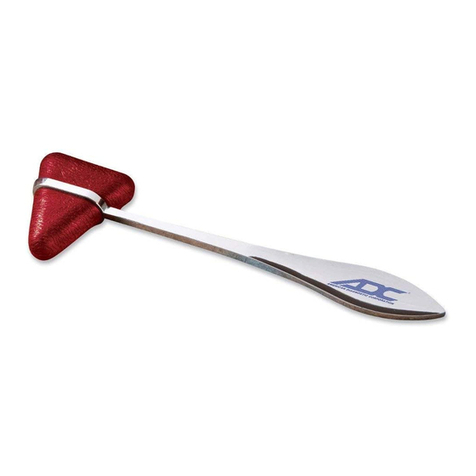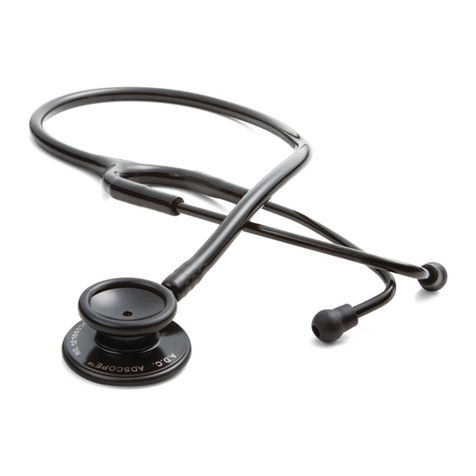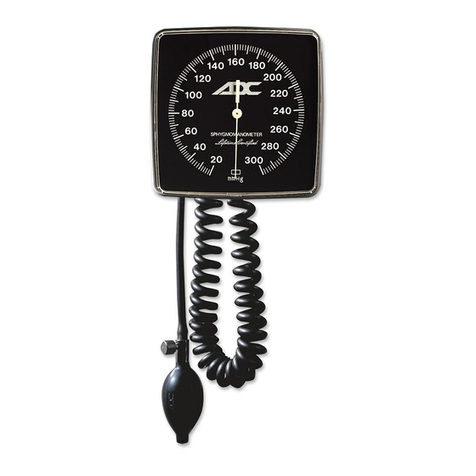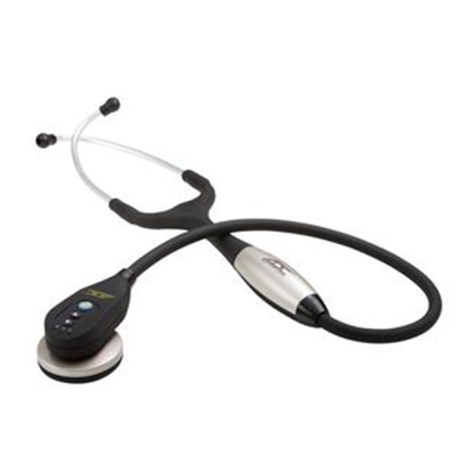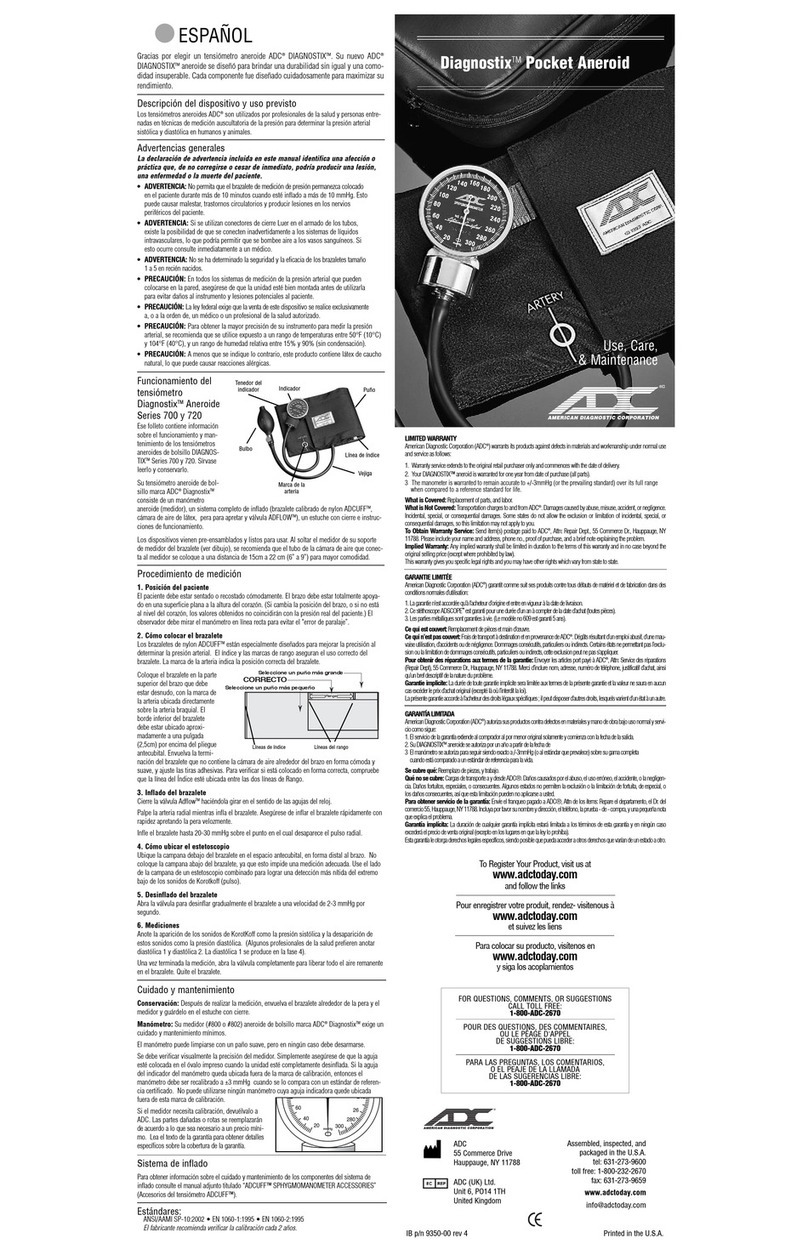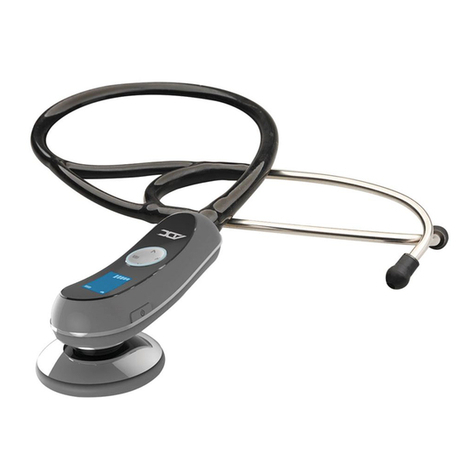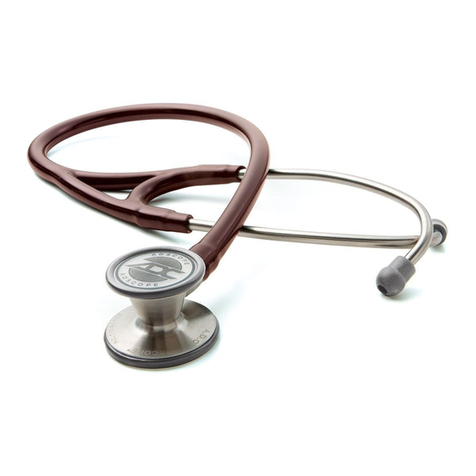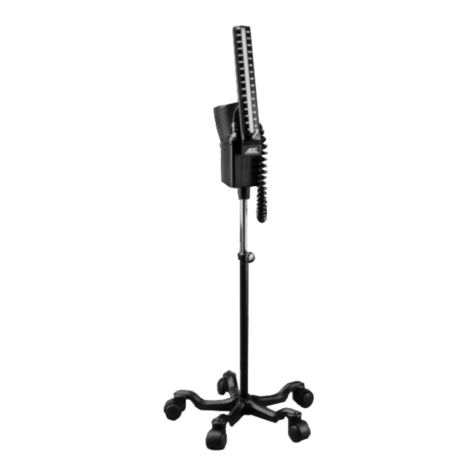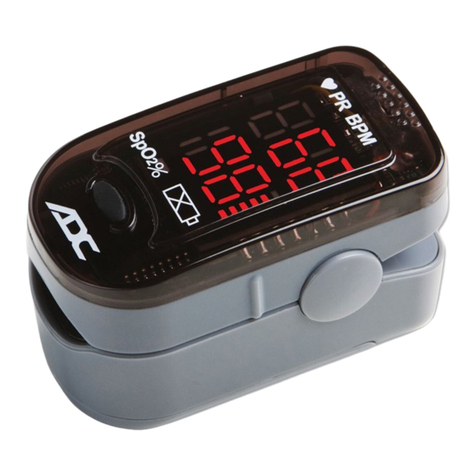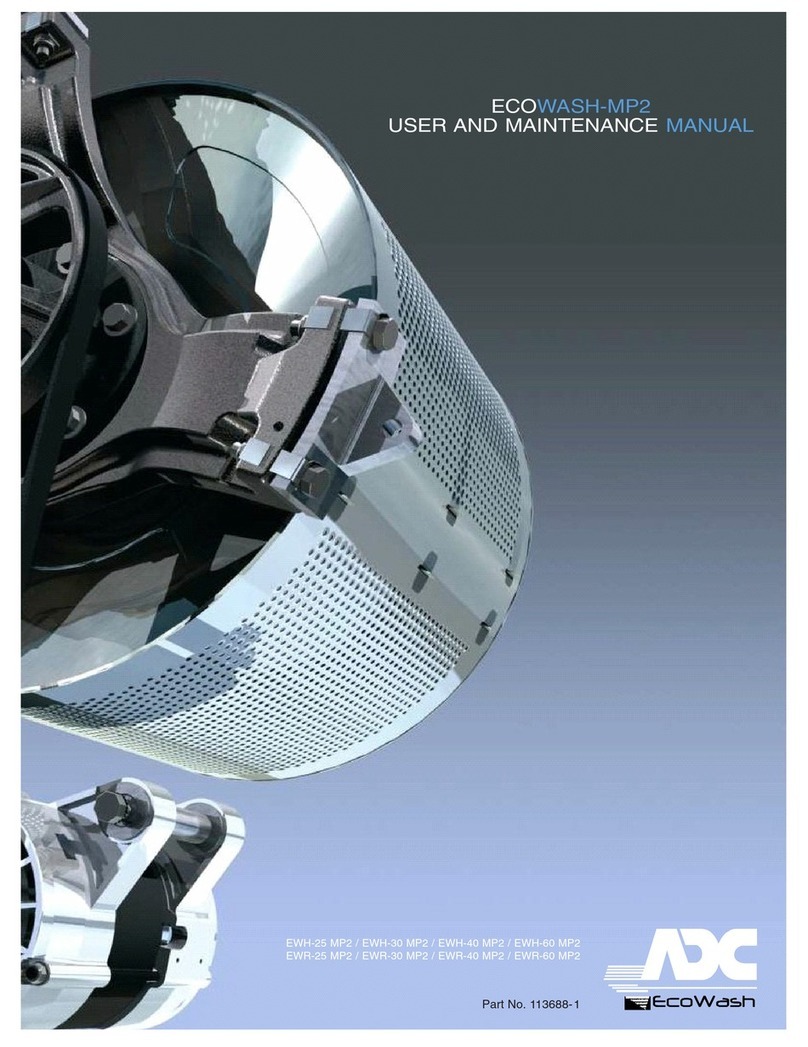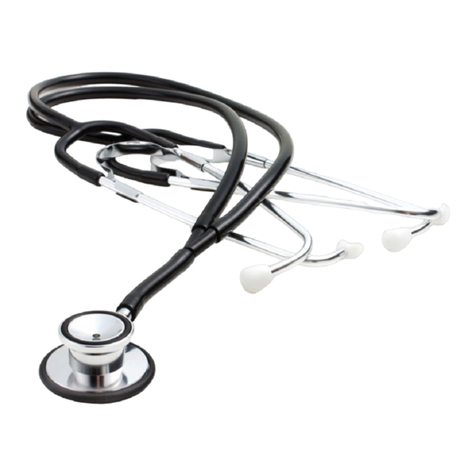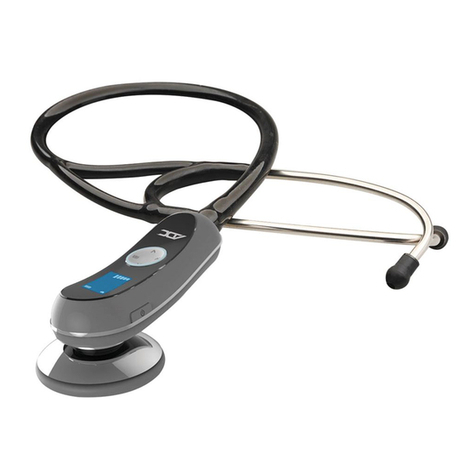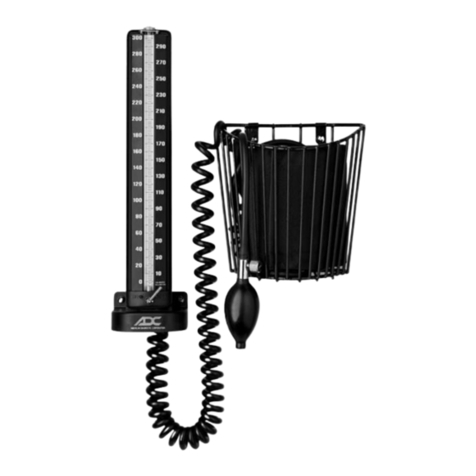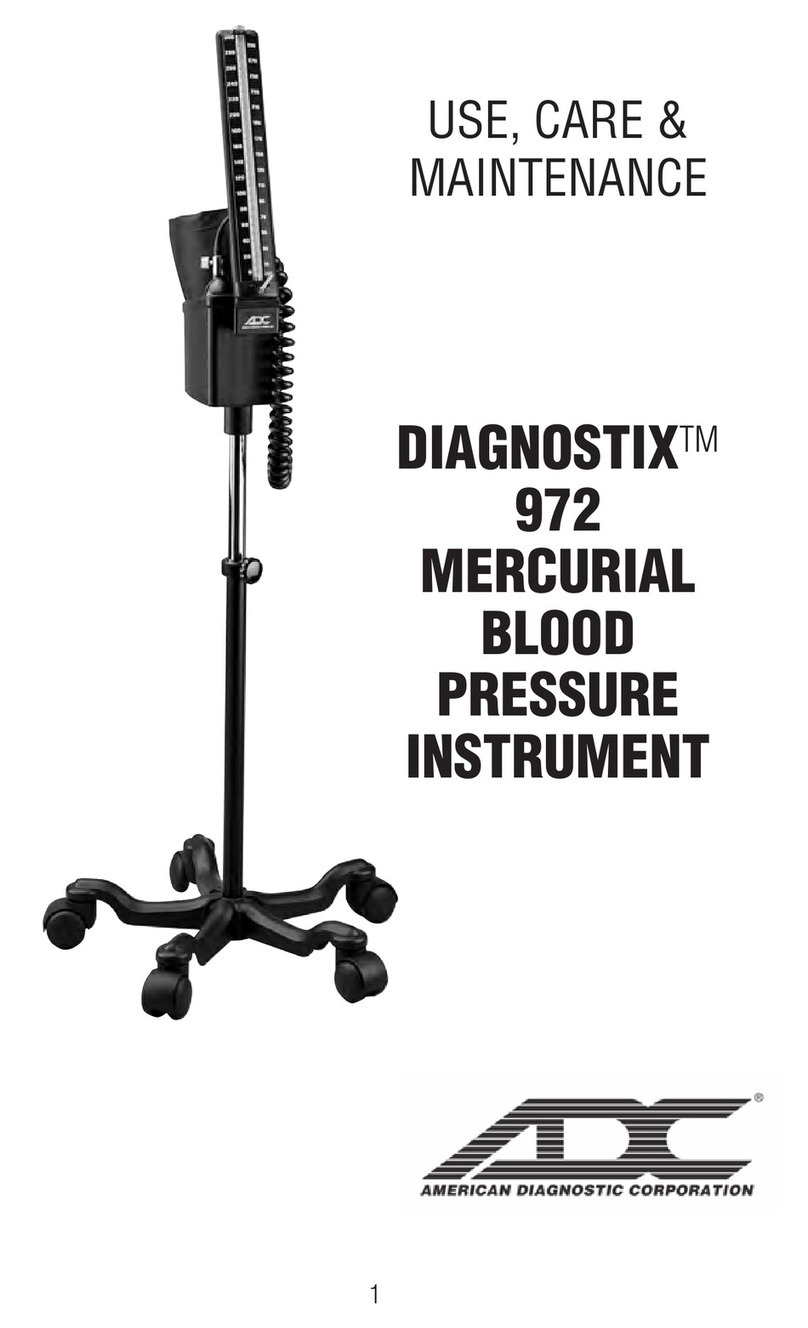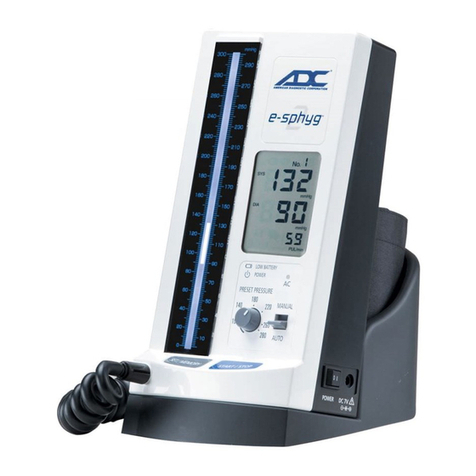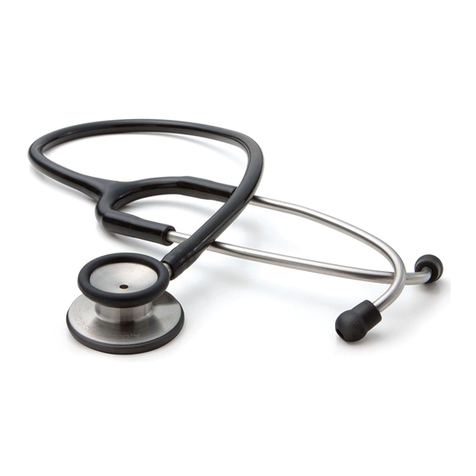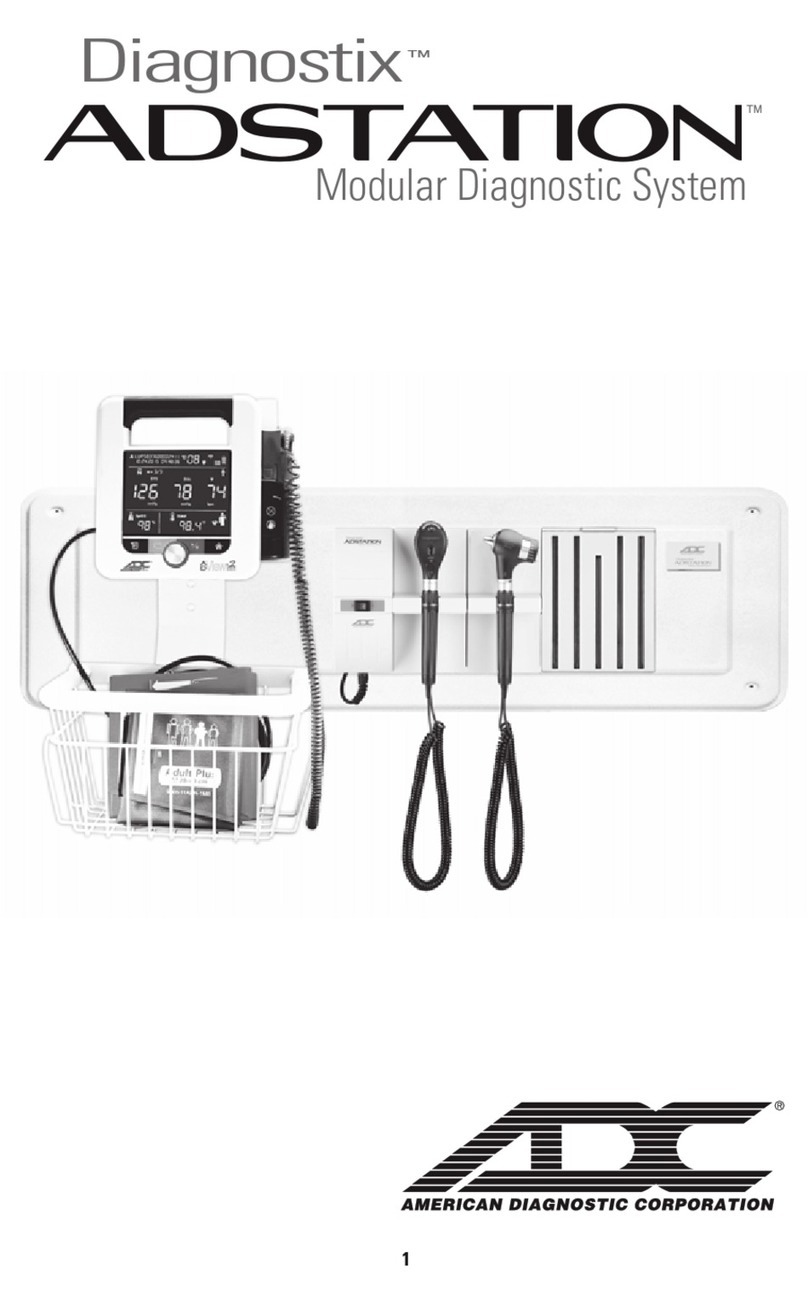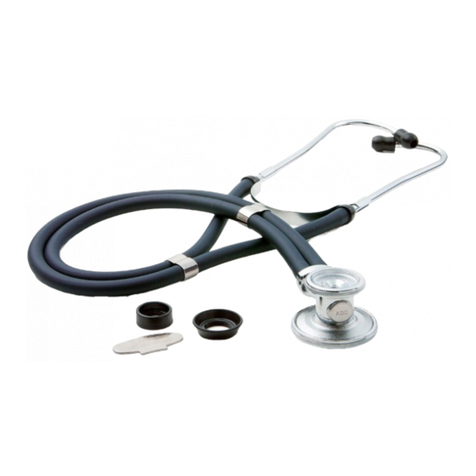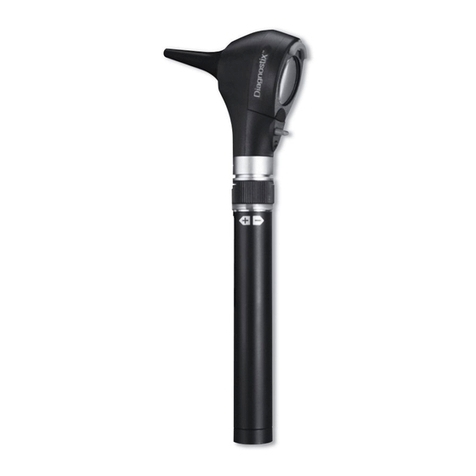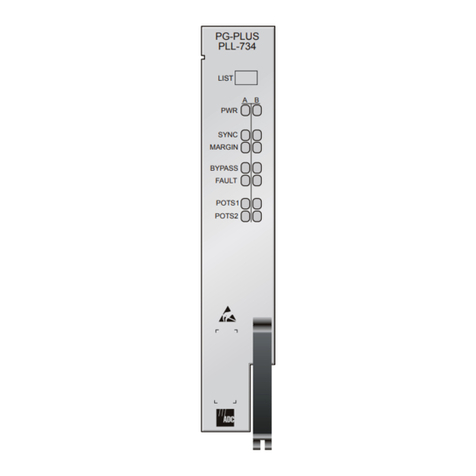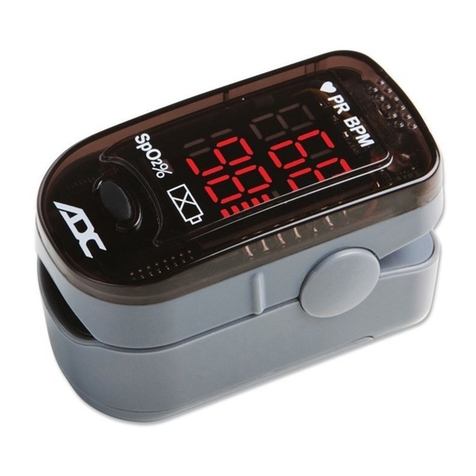
Thank you for choosing an ADC diagnostic set. We’re proud of the care and
quality that goes into the manufacture of each and every diagnostic instrument
that bears our name. Every component has been carefully designed to maximize
performance. This booklet refers to both otoscope and ophthalmoscope sets
(models 5110N series, 5110E, 5111N series, 5112N series).
Device Description and Intended Use
Ophthalmoscope Attachment (5110N Series, 5110E, 5112N Series)
The ophthalmoscope is a handheld, battery-powered device containing illumination
and viewing optics intended to examine the media (cornea, aqueous, lens, and
vitreous), the retina, blood vessels, optic nerve, and other structures of the eye.
It is intended to be used by a trained healthcare professional.
Otoscope Attachment (5110N Series, 5110E, 5111N Series)
A handheld battery-powered device with magnifying system that provides illumination
of the ear canal and tympanic membrane.
This device should be used by a trained healthcare professional.
Contraindications
The use of this device is contraindicated in patients who have already received
prolonged or intense light exposure, especially if the patients are infants,
aphakes, or persons with diseased eyes. Excessive exposure to light may result
in patient injury. See warnings for additional information.
Symbol Definitions
The following symbols are associated with your diagnostic instrument.
General Warnings
A warning statement in this manual identifies a condition or practice which,
if not corrected or discontinued immediately, could lead to patient injury,
illness, or death.
CAUTION: Because prolonged intense light exposure can damage the retina, the
use of the device for ocular examination should not be unnecessarily prolonged,
and the brightness setting should not exceed what is needed to provide clear
visualization of the target structures.
The retinal exposure dose for a photochemical hazard is a product of the radiance
and the exposure time. If the value of radiance were reduced in half, twice the
time would be needed to reach the maximum exposure limit.
While no acute optical radiation hazards have been identified for direct or indirect
ophthalmoscopes, it is recommended that the intensity of light directed into the
patient's eye be limited to the minimum level which is necessary for diagnosis.
Infants, aphakes, and persons with diseased eyes will be at greater risk. The
risk may also be increased if the person being examined has had any exposure
with the same instrument or any other ophthalmic instrument using a visible
light source during the previous 24 hours. This will apply particularly if the eye
has been exposed to retinal photography.
CAUTION: Do not immerse the battery handle in liquid. Consult the cleaning and
disinfection instructions for each part for further information about cleaning and
disinfecting this product. Never clean or disinfect any device with batteries in it.
CAUTION: Federal law restricts this device to sale by or on the order of a physician
or licensed healthcare practitioner.
CAUTION: Turn off instrument when not in use. Avoid powering on without an instrument
head attached. When storing this device for extended periods of time, remove the
batteries.
WARNING: The carrying cases provided with these devices are intended for
long-term storage or transport between facilities or when shipping devices to
and from ADC’s facility for repair or servicing. Carry cases (including internal
liners) cannot be cleaned or disinfected and should be safely discarded if
contaminated. Do not carry the case into a contaminated environment.
WARNING: When replacing lamp, allow lamp to cool for five minutes before handling.
WARNING: Only the approved sterilization method included in this IFU has been
validated for this device or its corresponding components. Any other sterilization
method may compromise the safety and effectiveness of this device. (This
includes steam sterilization.)
WARNING: Do not place devices or accessories back into carrying case after use
on a patient without first cleaning/disinfecting the device/accessories as
described in the cleaning and disinfection section of this manual.
WARNING: Use of any accessories or materials not indicated in the user's manual
can degrade the minimum safety of the equipment.
WARNING: Only replace listed accessories (attachments), lamps, or batteries for
the device.
WARNING: During use metal components near instrument head can become
warm. This is especially true if device is on for extended periods of time. Do not
leave device on when not in use.
WARNING: The light emitted from this instrument is potentially hazardous. The
longer the duration of exposure, the greater the risk of ocular damage. Exposure to
light from this instrument, when operated at maximum intensity, will exceed the
safety guideline after 3 minutes and 47 seconds. Exposure times are cumulative for
a 24 hour period.
Otoscope Parts and Assembly
The pocket otoscope consists of a AA battery handle (5160N), fiberoptic otoscope
instrument head (5120N series) with attached movable view-
ing lens, and disposable specula (2.75mm and 4.25mm).
Removing and Attaching the Instrument Head
Pocket otoscope heads are threaded and can be removed by
rotating the threaded connection counterclockwise, or
attached by rotating the threaded connection clockwise.
Viewing Lens
To move during an examination, turn the lens bezel clockwise
to lift up. To reposition, reverse procedure.
Attaching the Disposable Specula
Push the flanged end of the desired speculum onto the
stainless socket and twist clockwise to engage. Reverse
procedure to remove and discard after each use.
NOTE: Otoscope must be used with specula.
Pneumatic Otoscope
To perform, insert tapered end of insufflator fitting (5121N,
sold separately), into hole on side of otoscope head. Attach
optional bulb assembly (5122N, sold separately).
Ophthalmoscope Parts and Assembly
The pocket ophthalmoscope consists of AA battery handle (5160N) and
ophthalmoscope instrument head (5140N Series).
Aperture Selection
This unit is equipped with 5 internal apertures: small,
large, semi-circle, red-free, and fixation. To select,
rotate the aperture selection wheel at the front of the
instrument head.
Corrective Lens Selection
This unit is equipped with 19 corrective lenses from +20
to -20 diopters (negative lenses in red). To select, rotate
the corrective lens selection wheel at either side of the
instrument head. Selected lenses can be viewed in the
lighted panel on practitioner side of instrument.
Turning Instrument On
To illuminate, slide the on/off switch located on the
battery handle pocket clip away from the instrument
head. Slide the switch in the opposite direction to turn off.
Replacing Lamp
Remove the instrument head by turning counterclock-
wise. Grab end of lamp from inside base of instrument
head and remove. Replace with new lamp, taking care
not to touch the glass, and align lamp metal guides on
side of lamp with grooves in lamp socket (xenon ophthal-
moscope heads only).
NOTE: Allow lamp to cool for five minutes before handling
if device has been recently used.
*NOTE: Otoscope LED lamp cannot be replaced, must
order new head with lamp.
Battery Replacement
This unit requires 2 AA batteries. For best performance,
we suggest alkaline batteries. To replace, remove the
battery cap at the base of the handle by turning counter-
clockwise and replace batteries, taking care to observe
correct polarity.
NOTE: This instrument should be turned off when not
in use. If storing for extended lengths of time, remove
batteries completely.
Handle Care and Maintenance
Periodically check the condition of both the batteries, making sure there is no sign
of corrosion or oxidation. Always replace both batteries. Alkaline batteries are
recommended. Remove batteries from handle if instrument will not be used for
an extended period of time.
Cleaning and Disinfection
Basic Cleaning Procedure for Battery Handles, Otoscope and Ophthalmoscope
Heads.
To clean the exterior of the device, prepare a 70% isopropyl alcohol solution and
soak a lint-free cloth. Wipe down the exterior of the ophthalmoscope head and
handle, cleaning all external surface areas. Care should be taken to prevent
excess liquid from seeping into the components.
Isopropyl alcohol may be substituted with commonly used, EPA-registered
hospital disinfectant wipes for cleaning purposes if desired. Please refer to the
directions provided by the manufacturer of the wipes for appropriate instructions
for use to ensure effective contact time between the wipe and the device.
It is important to note that solution residue on the magnifying lenses may
decrease device performance. All excess cleaning fluids must be carefully wiped
clean if these surfaces are cleaned. The lenses of the instrument head may be
cleaned with a lint-free cloth or lens paper.
Steris Sterilization Processes
This product has been validated with the V-PRO 1 Standard Cycle; V-PRO 1 Plus
Lumen and Non Lumen Cycles; V-PRO maX Lumen, Non Lumen, and Flexible
Cycles; V-PRO 60 Lumen and Non Lumen Cycles using the V-PRO 60 Low
Temperature Sterilization System with VAPPROX HC Sterilant and V-PRO maX
Low Temperature Sterilization System.
Disposable Specula Cleaning/Disinfection Instructions
Disposable specula should not be cleaned or disinfected in any way. Disposable
specula are single-patient use only and must be discarded after use. Disposable
specula should not be used if they appear to be visibly contaminated or have
accidentally come into contact with contaminated materials prior to use.
Troubleshooting
The following guidelines should be used to determine if your device has reached
its end of life or requires servicing. If the corrective actions described in this
section do not resolve your issues, please see the warranty section of this
manual to have your device serviced.
OFF
ON
fi
Symbol Definition
Attention. Read operating manual
for cautions and instructions
for use.
Meets essential requirements of
European Medical Device
Directive 93/42/EEC
Authorized European
Representative’s Information
Medical device
Not made with natural rubber latex
Lot/Batch code
Symbol Definition
Phthalate free
Manufacturer’s Information
TYPE B. Indicates this is a product
with Type B applied parts
Do not dispose of this product
as unsorted municipal waste
Read the instruction manual
carefully before using this device,
especially the safety instructions,
and keep instruction manual for
future use
Lamp Replacement Part Numbers
Lamp Type Otoscope Ophthalmoscope
Hal/Xenon 5111N-4 5112N-4
LED 5120NL* 5112NL-4
9362-00 rev 10.qxp_Layout 1 10/5/21 2:25 PM Page 2
